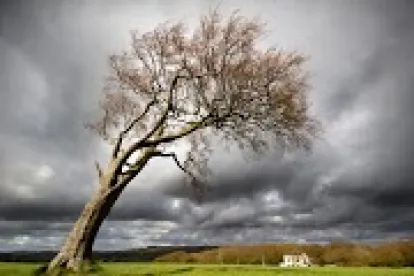For better or worse, banks frequently obtain possession of, or title to, pieces of property. Often times, these parcels of land have been neglected and are in poor condition. It would not be surprising to find a property that a bank obtained via foreclosure that had decaying trees looming over a neighbor’s fence. But what happens when that tree falls, causing damage to the neighbor’s property? Is the bank liable? Recently, in Corbin v. HSBC Bank USA, N.A., (June 3, 2016) the Connecticut Superior Court considered whether Connecticut recognizes a cause of action between private landowners for damage claims resulting from a falling tree where the tree fell onto private property.
In that case, the defendant bank owned a piece of residential property, and had the property listed with a real estate agent. The plaintiffs owned an adjacent parcel of land. The plaintiffs claimed that there was a tree located on the bank’s property that was decayed, dangerous and in an unsafe condition. The plaintiffs further alleged that they gave notice of the condition to the real estate agent, who later came to the property to photograph the condition. Thereafter, the tree fell onto the plaintiff’s property destroying their tool shed and all of its contents. The plaintiff brought suit asserting two claims: negligence and nuisance.
But what happens when that tree falls, causing damage to the neighbor’s property? Is the bank liable?
The bank moved to strike the complaint on the grounds that Connecticut does not recognize causes of action between private landowners for damage claims attributable to a falling tree where the tree damages private property. Citing the Restatement (Second) of Torts, the bank argued that the general rule is that there is no such liability between private landowners for damage caused by natural conditions. The Bank also noted that the Connecticut Legislature has attempted – but thus far failed – to pass legislation that would create liability between adjoining landowners for removal of trees as further evidence that Connecticut does not yet recognize the plaintiff’s claims.
The plaintiffs countered that the Restatement is disfavored and that the better rule is one where a landowner or possessor of land is liable for damages that result from a defective condition if the landowner had notice of the defective condition. The plaintiff pointed to other jurisdictions that take this approach.
Ultimately, the court rejected the plaintiff’s invitation to adopt a different approach, instead finding in favor of the bank that Connecticut common law barred the plaintiff’s claims. The court found that the Restatement has been favorably cited by other Connecticut courts. The court also noted that the fact that the legislature has attempted to enact a law that would require a landowner to pay for tree removal (likely due to the enormous cost that would result after a large storm) was further evidence that the plaintiff could not pursue the claims against the bank.
The ruling in this case is not binding on other superior courts, and so a bank may not want to sit idly by if it has knowledge of a dangerous condition on one of its properties. However, Corbin provides a recent useful example that can be used when fighting similar claims. Banks should also monitor further legislative efforts to enact a law that would create liability between adjoining landowners.




 />i
/>i

